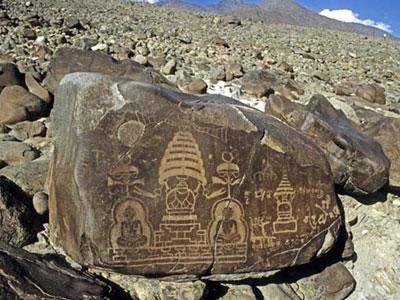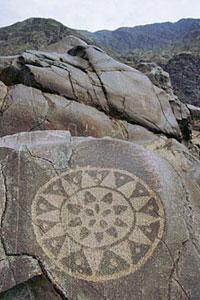
DailyIndia reports that the proposed sight of the Basha-Diamer Dam in Pakistan, holds thousands of ancient rock carvings and inscriptions. If the construction of the dam goes ahead around 30,000 carvings on 5,000 rocks would be affected. Some would be totally submerged and some would be seasonably visible when water levels were low.
Professor Harald Hauptmann, head of a research project entitled “Rock Carvings and Inscriptions along the Karakorum Highway”, told Dawn.com that a total of 37,051 carvings on 5,928 boulders or rock faces would be inundated after the construction of the Diamer-Basha Dam.
The site hosts hundreds of inscriptions in Brahmi, Sogdian, middle Persian, Chinese, Tibetan and Hebrew languages. Some 80 per cent of the writings are in Brahmi language.
These writings not only provide insights into the religious and political situation but also show the name of the rulers and a rough date of the time. The earliest rock carvings in northern Pakistan dates back to the ninth millennium BC (roughly late Stone Age).
When asked about the importance of the rock carvings in one hand and the need of the dam on the other, Hauptmann said: “We (as an archaeologist) have to respect the decision (to build the dam), but it is very sad for us to lose one of the most rich and diverse rock art provinces of the world.”
According to Hauptmann, the Basha Dam will drown 32 villages and displace more than 25,000 people, and some 3,000 very important stupas and a similar number of drawings will be submerged after the construction of the dam.

The World Monuments Fund gives further background on the petroglyphs:
Meandering through gorges of the Indus River valley and across high mountain passes, ancient arteries of the fabled Silk Road cut through the Diamer District of Northern Pakistan. Along these pathways, thousands of petroglyphs cover cliffs, rock faces, and boulders, standing testament to the ancient cultures that once settled in this region and the merchants, pilgrims, and conquerors who later journeyed through it. Over 50,000 rock carvings and 5,000 inscriptions serve as a timeline from the Epipaleolithic period to the pre-Islamic “golden era” of Buddhism. The earliest petroglyphs, which depict wild animals such as ibex and sheep, were created by groups of hunter-gathers first drawn to the region in the early Holocene. By the first millennium B.C., Scytho-Saka tribal groups from Central Asia had introduced the Eurasian animal style of drawing. As this region developed into a dynamic Himalayan crossroads in the Silk Road era, more petroglyphs exhibited Buddhist iconography and architectural forms, most importantly associated with the building of stupas.
The full DailyIndia article can be viewed here and more information on the World Monuments Fund action plan can be found here.
Photos from the World Monuments Fund website.








Those petroglyphs are fantastic!!! Thanks for all of that background information.
It is fascinating isn’t it?
This has always been an issue – Aswan, for example. Hard to know the rights and wrongs here.
In all instances if the people are considered first everything will slot into place.
I the case of the Basha-Diamer Dam the people in the affected area, the ones who will be displaced should be considered first. What is the right thing for them?
They look fascinating, sad to think that they may be under threat. I can only assume that the Dam is somewhat important?
I think the dam it it felt that the dam is necessary to provide for the region.
They will be “lost”? Eh… 5000 rocks can readily be moved by people with the engineering skills to build a big dam, even if it means slicing the carvings off of any huge rocks, just as many, many, fossils have been removed, although the one in the picture looks easy to lift with machinery. Instead of a threat this sounds like a wonderful opportunity to make them all much more accessible that they are now in a museum beside the dam. First I’ve heard of them, so the dam may be just what they need to get the recognition and viewing they deserve.
I’m with Andrew on this, just move them to a display area. If it’s near the dam then people will see them when they visit the dam. Where they are few people will have seen them so why not take the opportunity to display them to a wider public or is it a case of the ‘experts’ wanting them as their own private reserve.
Andrew & Ivan,
Yes I agree the artefacts should be preserved and moved to a suitable place. There is talk of preserving them in a museum for future generations.
But what about the 25,000 people who will be displaced…
In any other country I would say the people would see it as a way of advancement – a reason to try new things, as in China and the three gorges dam.
In Pakistan there are the problems of tribalism and religion to contend with – the very things that are keeping those in the countryside poor and oppressed. You only have to see the aftermath of the earthquake of a few years ago to see how the people return to the old place and continue scratching out a living the old way instead of trying something new.
I think the people of most countries don’t recognise opportunities for advancement, they feel comfortable with what they know. They are either to scared or not prepared to explore what else may be possible. Some countries are more advanced (in thinking) than others.
The religious stumbling block can be seen in the comments section in the following related blog post:
May 18 @ 5pm
Dear Enlightenment: If there is no food to eat and workm there will be chaos and disaster. Pakistan simply does not have the means nor the love or desire to save these carvings. After it is meaningless when viewed from a Muslim perspective. So take pictures study them well and build the dam. Nothing can be done.
http://www.dawn.com/2011/05/18/basha-dam-threatens-thousands-of-ancient-rock-carvings.html
That example is so sad but true from my experience in working round the world.
They are so wrong that nothing can be done but this is what you get by being steeped in 12 th century philosophy.
Yes the example is sad…
But the most sad thing for me is the people think that nothing can be done. So many things can be done if you just try…
This is outrageous!
Planning should be not be approved at all.
It is a difficult thing to consider…
The most important thing is how can the people be sustained in their environment.
The World Bank estimates that forcible “development-induced displacement and resettlement” now affects 10 million people per year. According to the World Bank an estimated 33 million people have been displaced by development projects such as dams, urban development and irrigation canals in India alone.
India is well ahead in this respect. A country with as many as over 3600 large dams within its belt can never be the exceptional case regarding displacement. The number of development induced displacement is higher than the conflict induced displacement in India. According to Bogumil Terminski an estimated more than 10 million people have been displaced by development each year.
Athough the exact number of development-induced displaced people (DIDPs) is difficult to know, estimates are that in the last decade 90–100 million people have been displaced by urban, irrigation and power projects alone, with the number of people displaced by urban development becoming greater than those displaced by large infrastructure projects (such as dams). DIDPs outnumber refugees, with the added problem that their plight is often more concealed.
This is what experts have termed “development-induced displacement.” According to Michael Cernea, a World Bank analyst, the causes of development-induced displacement include water supply (dams, reservoirs, irrigation); urban infrastructure; transportation (roads, highways, canals); energy (mining, power plants, oil exploration and extraction, pipelines); agricultural expansion; parks and forest reserves; and population redistribution schemes.
Very interesting, thank you